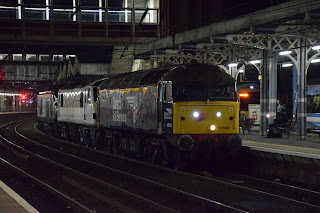Peter Skuce Reports - PART 7 (GWML).
* London Paddington – Reading – Didcot – Swindon – Bath – Bristol
* London Paddington – Reading – Didcot – Swindon – Newport – Cardiff – Swansea
* London Paddington – Reading – Newbury – Taunton – Exeter – Plymouth – Penzance
History:
British Railways built thirty eight Class 42 Warship Diesel Hydraulic locomotives between the period 1958 – 1961 at Swindon Works, powered by two Maybach MD650 engines. Also British Railways built seventy four Class 52 Western Diesel Hydraulic locomotives between the period 1961 – 1964 at Swindon Works, powered by two Maybach MD655 engines. Both classes 42 and 52 were designed for intercity express passenger trains formed of British Railways Mark 1. They had a top speed of 90 mph.
For secondary services and to haul goods traffic, British Railways ordered hundred and one Class 35 Hymek Diesel Hydraulic locomotives from Beyer Peacock during the period 1961 – 1964. These locomotives were powered by Maybach MD870 engines and had a top speed of 90 mph.
To cater for both local branch line and suburban work, British Railways ordered thirty eight, 3 carriage Class 117 DMU trains from Pressed Steel, during period 1959 – 1961. One driving motor vehicle housed Standard Class accommodation, an intermediate trailer housed First Class cabin, two toilets and Standard Class accommodation and finally another driving motor vehicle housed both Guard’s brake van as well as Standard Class accommodation. The driving motor vehicles were powered by Leyland 680 engine and the trains had a top speed of 70 mph.
During 1976-77 British Rail built the High Speed Train/InterCity Class 43 Power Cars and Mark 3 trailer carriage vehicles. The Class 43 Power Cars were Diesel Electric and the Mark 3 trailer carriage vehicles were 23 metres long and had slab florescent lighting diffusers, air conditioning, InterCity 70 seats and fully carpeted throughout. These High Soeed Train/InterCity 125 sets replaced the non standard Diesel Hydraulic locomotives.
The Class 117 DMU trains were refurbished during the early 1980s and again from 1986 onwards with relivery into Network SouthEast ‘toothpaste’ colours of red/blue/white/grey and internally the seats reupholstered in Network SouthEast ‘blue blaze’ moquette trim.
From 1991 onwards, British Rail built the Class 165 Network Turbo DMU trains to replace the ageing Class 117 DMU trains. There are seventeen 3 carriage Class 165/1 Thames Turbo DMU trains (165101 - 165117) and nineteen 2 carriage Class 165/1 Thames Turbo DMU trains (165118 - 165137). There is a total of thirty seven Class 165/1 Thames Turbo DMU trains. These new build trains would have sliding plug doors, non slip flooring, high backed seats to the 2+3 layout in Standard Class accommodation and improved interior saloon lighting diffusers as well as a higher maximum speed of 90 MPH. Each carriage is powered by a 350 horsepower Perkins diesel engine. The two carriage length Class 165 are for Thames Valley Branch lines, whilst the three carriage length Class 165 are for London Paddington – Reading and London Paddington – Oxford routes.
Then in 1993, British Rail built it’s last ever DMU train, the twenty one strong fleet of 3 carriage Class 166 Network Turbo Express DMU trains. These were primarily designed for both London Paddington – Oxford and Reading – Gatwick Airport routes, as they were fitted with large vertical luggage stacks and were carpeted throughout. The Class 166 Network Turbo Express is fully carpeted throughout and again, like the Class 165, feature high backed seats to the 2+3 layout in Standard Class accommodation and improved interior saloon lighting diffusers as well as a higher maximum speed of 90 MPH. Each carriage is powered by a 350 horsepower Perkins diesel engine. These trains also feature on both London Paddington – Reading and London Paddington – Oxford routes.
Both trains bought the end of guards being employed on board trains to ensure doors were closed and giving the starting signal to the driver, as the trains are Driver Only Operation (DOO for short).
A new catering concept was developed by First Great Western during the late 1990s, it was the Travelling Chef. This was a chef cooking breakfasts and light meals, served at seat to First Class passengers and to take away by Standard Class passengers. In addition to this, the Pullman Dining Restaurant services were improved and updated with new Brunch services from London Paddington to both Cardiff and Plymouth.
First Great Western completely stripped down and refurbished all High Speed Train/InterCity 125 Mark 3 trailer carriages with new carpets, brand new bespoke high back seats, new dado side panels & repainted wall ends and improved interior saloon florescent lighting diffusers. As well as rebuilding the Class 43 Power Cars by replacing the Paxman Valenta 12 cylinder engine with the new MTU 16v4000 engine during the period 2006-8.
More recently during 2010, the Turbo fleets were given an interior refresh with new vinyl flooring (carpet aboard Class 166 Turbo Express DMU trains), retrimmed seats in new moquette trim, new dado side panels and wall end coverings, repainted ceilings and refreshed toilet cubicles.
This takes us up to the present day, so see recent posts of the region under the GWR tag. Peter.








